
A rangefinder camera is a camera fitted with a rangefinder, typically a split-image rangefinder: a range-finding focusing mechanism allowing the photographer to measure the subject distance and take photographs that are in sharp focus.
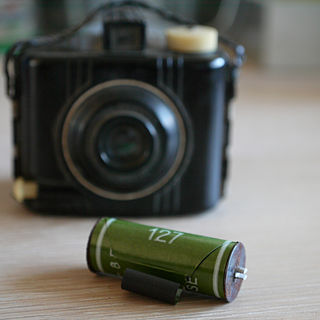
127 is a roll film format for still photography introduced by Kodak in 1912.
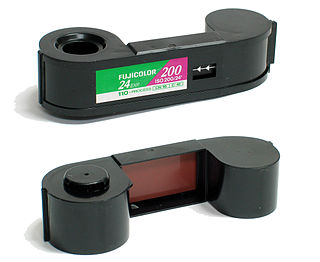
110 is a cartridge-based film format used in still photography. It was introduced by Kodak in 1972. 110 is essentially a miniaturized version of Kodak's earlier 126 film format. Each frame is 13 mm × 17 mm, with one registration hole. Cartridges with 12, 20, or 24 frames are available on-line. Production variations sometimes have allowed for an additional image.
IMAX is a proprietary system of high-resolution cameras, film formats, film projectors, and theaters known for having very large screens with a tall aspect ratio and steep stadium seating, with the 1.43:1 ratio format being available only in few selected locations.
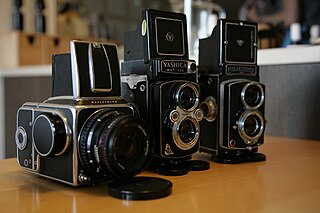
Medium format has traditionally referred to a film format in photography and the related cameras and equipment that use film. Nowadays, the term applies to film and digital cameras that record images on media larger than the 24 mm × 36 mm used in 35 mm photography, but smaller than 4 in × 5 in.

An overhead projector, like a film or slide projector, uses light to project an enlarged image on a screen, allowing the view of a small document or picture to be shared with a large audience.

Minolta Co., Ltd. was a Japanese manufacturer of cameras, camera accessories, photocopiers, fax machines, and laser printers. Minolta Co., Ltd., which is also known simply as Minolta, was founded in Osaka, Japan, in 1928 as Nichi-Doku Shashinki Shōten. It made the first integrated autofocus 35 mm SLR camera system. In 1931, the company adopted its final name, an acronym for "Mechanism, Instruments, Optics, and Lenses by Tashima".

A movie projector is an opto-mechanical device for displaying motion picture film by projecting it onto a screen. Most of the optical and mechanical elements, except for the illumination and sound devices, are present in movie cameras. Modern movie projectors are specially built video projectors.
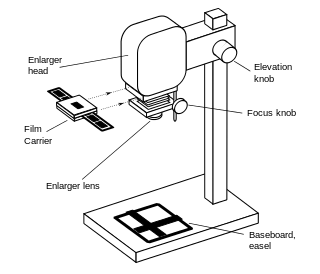
An enlarger is a specialized transparency projector used to produce photographic prints from film or glass negatives, or from transparencies.
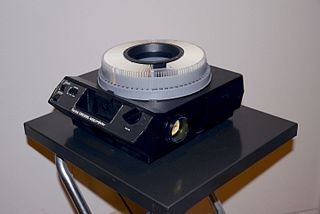
A carousel slide projector is a slide projector that uses a rotary tray to store slides, used to project slide photographs and to create slideshows. It was first patented on May 11, 1965, by David E. Hansen of Fairport, New York. Hansen was an industrial designer at the Eastman Kodak Company. A patent for the rotary tray was granted in 1966 after a 1962 application by the Eastman Kodak Company.
The Slide Cube Projector is a slide projector and system, manufactured and marketed by Bell & Howell, which was introduced in 1970 and marketed through the 1980s. The projector derived its name from its transparent cubical plastic slide storage magazine, approximately 5.5 cm (2.2 in) in each dimension, that held 36 to 44 slides, depending on the mount thickness. The magazine used a sliding lid to hold the slides in place. Unlike competing systems which used straight tray or carousel magazines, the slides in a Slide Cube are stacked on top of each other rather than stored in separate slots.

Rollei was a German manufacturer of optical instruments founded in 1920 by Paul Franke and Reinhold Heidecke in Braunschweig, Lower Saxony, and maker of the Rolleiflex and Rolleicord series of cameras. Later products included specialty and nostalgic type films for the photo hobbyist market.

Jos. Schneider Optische Werke GmbH is a manufacturer of industrial and photographic optics. The company was founded on 18 January 1913 by Joseph Schneider as Optische Anstalt Jos. Schneider & Co. at Bad Kreuznach in Germany. The company changed its name to Jos. Schneider & Co., Optische Werke, Kreuznach in 1922, and to the current Jos. Schneider Optische Werke GmbH in 1998.
The Hektor is a photographic lens design manufactured by Leica Camera. The first "fast" lens available for the Leica I(A) was the Hektor 50mm f/2,5. Later, the design was adapted for use as a long portrait lens, available first in a 73mm f/1.9 and 135mm f/4,5 screw-mount version and later in a 125mm f/2,5 bayonet-mount version. It is reported that Max Berek, who designed the original lens line for Leitz, named the "Hektor" after his dog.

The Stereo Realist is a stereo camera that was manufactured by the David White Company from 1947 to 1971. It was the most popular 35 mm stereo camera ever manufactured and started the era of popular stereo photography of the mid 20th century.

The Rollei 35 is a 35mm miniature viewfinder camera built by Rollei. The original Rollei 35, when introduced at photokina in 1966, was the smallest existing 135 film camera. The Rollei 35 series remains one of the smallest 35 mm cameras after the Minox 35 and Minolta TC-1. In 30 years, about 2 million Rollei 35 series cameras were manufactured. The Rollei 35 was manufactured by DHW Fototechnik up to 2015, the successor of Franke & Heidecke as small-batch production. The last version is the Rollei 35 Classic, an updated Rollei 35 SE.

Standard 8 mm film, also known as Regular 8 mm, Double 8 mm, Double Regular 8 mm film, or simply as Standard 8 or Regular 8, is an 8 mm film format originally developed by the Eastman Kodak company and released onto the market in 1932.

A projector or image projector is an optical device that projects an image onto a surface, commonly a projection screen. Most projectors create an image by shining a light through a small transparent lens, but some newer types of projectors can project the image directly, by using lasers. A virtual retinal display, or retinal projector, is a projector that projects an image directly on the retina instead of using an external projection screen.
Iscorama was a trademark applied by ISCO Optics of Göttingen to a series of consumer-grade anamorphic lenses manufactured between the late 1960s and the beginning of the 21st century. These lenses were notable for their high optical quality and unique focusing characteristics, and with the advent of DSLR-based film making have attracted much interest from independent cinematographers and directors.






















